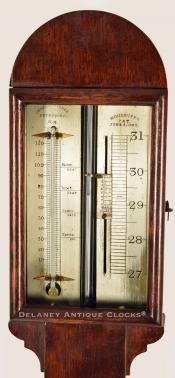Charles Wilder, Peterborough, New Hampshire. Mahogany case dome top wall barometer. 219118B.
This is an American-made stick barometer. It was made by Charles Wilder of Peterborough, New Hampshire.
This instrument is cased in mahogany and retains an older finish that allows one to see the grain exhibited in the wood. The color of the case has a lot of brown that shows through. This form is one of three case styles that Wilder offered and is seen in some level of quantity. It has a straight glass tube with a cast-iron cistern at the bottom. It is this cistern that relates to Woodruff's Patent. The vernier is operated manually. A slide is located aside from the tube on the right. This plate is engraved with the scale in inches. At the top is the reference to "WOODRUFF'S / PAT. / June 5 * 1860." An alcohol-based thermometer is mounted on the engraved brass plate located to the left of the barometer tube. At the top of this plate is the Maker's name, "CHARLES WILDER/ PETERBORO, / N.H." Both brass plates are finished in a silver wash.
This instrument is complete. It was made circa 1870.
Overall, this barometer measures approximately 37.25 inches long.
Inventory number 219118B.
Charles Wilder was born the son of Mark and Eliza Ann ( Thayer ) Wilder. He attended the common schools and the Academy in Peterborough, New Hampshire. Charles became a popular teacher at the Academy and later the Principal. He had planned to continue his education and become a lawyer, but his father's debts forced him into the family business of manufacturing shoe pegs. He pursued this business for two years when in 1860, he secured the rights to manufacture portable mercury barometers under a patent issued to Mr. Lum Woodruff of Ann Arbor, Michigan. Lum Woodruff reported weather observations to the Smithsonian Institution. He patented a portable barometer that proved to be extremely popular. Its key feature was a divided cistern. It was constructed so that when the glass tube was full of mercury, the lower portion of the cistern would be as well. As a result, it could be shut off from the now-empty upper section. In the fall of 1861, Charles Wilder converted an old factory in Peterborough into a barometer shop. He began touting the virtues of Woodruff's instrument. He claimed that it was "simple, durable, accurate, perfectly portable, and very cheap" and "a very beautiful and ornamental piece of furniture." It promised farmers a five percent savings on all their crops. For scientific men, it offered "superior accuracy." And for "gentlemen of leisure and cultivation," it offered a "never ending and constantly varying study of interest." All three of Wilder's standard barometer designs had a natural position and use for a thermometer. His scale in Fahrenheit ranged from 0 to 110 degrees. Wilder Barometers were sold throughout the United States by advertising through the leading agricultural periodicals of the day. As a successful businessman and prominent citizen, he was an active member and supporter of his Church. He served as a representative to the state legislature in 1869 and 1870 and was also a town moderator in 1869. He died in 1900. The business continued for a short time until it was sold to the W. & L. E. Gurley Instrument Company of Troy, New York. (Please note that most of this information was provided by the Peterborough, New Hampshire Historical Society.)








